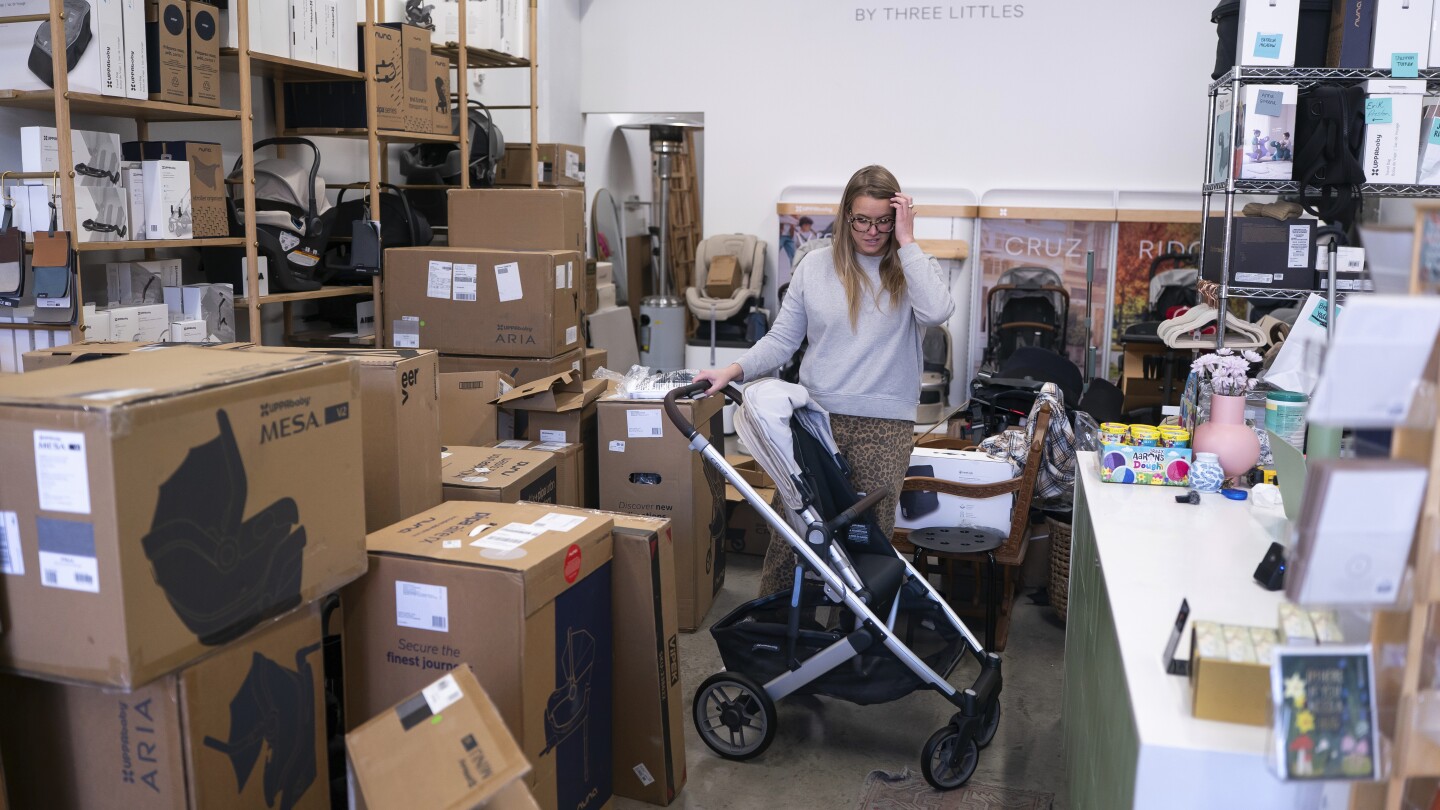Lifestyle
This cutting edge hair loss treatment is a repurposed drug from the 1990s

WASHINGTON (AP) — The latest trend in treating hair loss may sound familiar — essentially, it’s a repurposed drug first popularized in the 1990s.
Back then, TV viewers were inundated with ads for Rogaine, a sticky topical solution that could help treat thinning hair when applied to the scalp.
Now dermatologists are increasingly prescribing the drug, known generically as minoxidil, in low-dose pills to help men and women maintain or regrow hair.
The practice follows several recent studies suggesting the ingredient works as well — or possibly better — when swallowed, rather than applied to hair follicles on the head. Telehealth companies are also driving new demand by offering a quick, easy way to get a prescription and have the pills shipped directly to customers’ doors.
Here’s a look at the drug:
A retro approach to hair loss
Minoxidil was originally developed as a pill to treat high blood pressure in the 1970s. Researchers noticed that some patients taking it experienced increased hair growth as a side effect.
Rogaine was approved by the Food and Drug Administration in 1988, the first drug to win the agency’s endorsement for male pattern baldness. Studies showed that men on the medication, which was applied directly to the scalp, had a slower rate of hair loss and, in some cases, regrew hair.
Starting in 1991, a lower dose was approved for women and the brand was aggressively marketed as an over-the-counter medication on TV and in print.
This article is part of AP’s Be Well coverage, focusing on wellness, fitness, diet and mental health. Read more Be Well.
The drug’s ability to slow hair loss is likely related to its effect on blood circulation, according to experts.
“By increasing blood flow to the scalp it signals hairs to stay in their growth phase for longer,” said Dr. Adam Friedman, chair of dermatology at George Washington University. “We’re trying to keep those hairs in that growth phase as long as possible.”
A recent consensus paper by more than 40 U.S. and international dermatologists concluded that minoxidil pills are effective and often more convenient and affordable than the liquid formulation.
Patients prefer the pill
There’s little research comparing the two forms of minoxidil, but many dermatologists believe the drug works better as a pill.
At a chemical level, minoxidil is absorbed more directly when digested in the gut than when applied to the hairline. It’s also more convenient, with patients taking the drug by mouth once a day, instead of applying the liquid once or twice daily using a dropper.
“As you can imagine, that can be rather onerous,” said Dr. Susan Taylor of the University of Pennsylvania. “Although people often enthusiastically begin therapy— and even see results — after a while there are many who drop off.”
The doses prescribed for oral use are also very low. Dermatologists often direct men to take one half of the lowest-dose pill; women may only need a quarter of a pill.
Those low doses can also reduce the chances for side effects, which can include dizziness, rapid heartbeat and swollen legs. The drug isn’t recommended for people with a history of heart issues or who are pregnant or breastfeeding.
The only other FDA-approved medication for hair loss is finasteride, sold under the brand name Propecia, a drug that blocks a byproduct of testosterone that triggers hair loss in men. That drug is generally considered more effective than minoxidil, but it can occasionally cause troubling sexual side effects, including erectile dysfunction. For optimal results, some dermatologists prescribe the two drugs in combination.
Why aren’t minoxidil pills FDA-approved for hair loss?
In short, because there’s very little money to be made.
Minoxidil’s patent has expired and it is now available as a low-cost generic medication. That means drugmakers have little financial incentive to spend millions on the new studies that would be needed to win FDA approval for hair loss.
“For a drug like oral minoxidil — which is as old as dirt at this point — there are no reasons to do that,” said Friedman. Like other dermatologists, Friedman gives hair-loss patients a prescription for the pills intended to treat blood pressure, a practice known as off-label prescribing.
The upside for patients is that minoxidil is extremely affordable, with some pharmacies offering a month’s supply for less than $5.
“Not a single patient has complained to me about the cost of this medication, which is extremely rare,” said Dr. Luiz Garza of Johns Hopkins University.
Telehealth firms open up access
The vast majority of doctors prescribing minoxidil for hair loss are dermatologists, who often turn to older drugs off-label for various hair and skin conditions.
A survey of U.S. dermatologists published last year found 80% reported prescribing oral minoxidil. But with only about 12,000 dermatologists in the U.S., some patients may have trouble finding a provider.
Telehealth providers like Hims and Ro say they are helping fill the gap. Their business model offers patients quick access to the medications they are seeking, often after simply filling out a questionnaire about their medical history, medications and treatment goals. The information is reviewed by a health provider who can quickly approve a prescription, assuming there are no red flags.
Hims and Ro each say that their providers won’t prescribe minoxidil for patients who have complicating health conditions or prescriptions that could negatively interact with the drug. In some cases, patients may be referred for an office visit.
Many dermatologists say patients are better served by an in-person appointment, where a doctor will usually take a blood pressure reading, evaluate their medical history, prescriptions and discuss the drug’s side effects.
“I’m not a proponent of going to an online service,” said Taylor. “I recommend seeing your board-certified dermatologist who’s trained, who knows the data and can evaluate all of you.”
___
The Associated Press Health and Science Department receives support from the Howard Hughes Medical Institute’s Science and Educational Media Group and the Robert Wood Johnson Foundation. The AP is solely responsible for all content.
Lifestyle
Queen Elizabeth II’s favorite dog breed race for glory in the UK’s Corgi Derby

LONDON (AP) — Some of the fastest canines on four very short legs have raced for glory in Scotland’s annual Corgi Derby.
The Musselburgh Racecourse Corgi Derby was first held in 2022 to mark Queen Elizabeth II’s 70 years on the throne. The late monarch was a devoted corgi fan who owned almost 30 of the breed over the decades, along with a few dorgis – a corgi-dachshund cross.
Four-year-old Juno beat a 16-strong field of dashing dogs dressed in bright sweaters over the 230-foot (70-meter) race on Saturday at the racecourse outside Edinburgh. She came from behind in the final stretch to beat last year’s winner, Rodney.
The winner and her owners, Alisdair Tew and Fran Brandon, were presented with a trophy and dog treats by tennis coach Judy Murray, mother of Scottish star Andy Murray.
Tew told the BBC that “we trained her for this last year but this year we just resorted to just letting her chasing things, particularly seagulls” on Edinburgh’s Portobello Beach.
“Juno is always ready for treats -– that is probably why she won,” he said.
Elizabeth’s love of corgis began in 1933 when her father, King George VI, brought home a Pembroke Welsh corgi they named Dookie
Corgis were often by Elizabeth’s side in the decades before her death in September 2022 — accompanying her on official tours, reportedly sleeping in their own room at Buckingham Palace and occasionally nipping the ankles of visitors or royal family members.
Three corgis even appeared alongside the queen as she climbed into James Bond’s waiting helicopter in the spoof video that opened the 2012 London Olympics.
Lifestyle
Tariffs are likely to make having a baby cost more

Sam Rutledge and his wife have a baby due in mid-July, so they thought they had a few more months to research and buy the gear they’ll need.
But President Donald Trump’s tariff announcement in early April turned the couple’s slow walk into a sprint. In the past few weeks, they’ve bought two strollers, a car seat, a nursery glider, a crib and a high chair. All of them are made overseas.
“These are all pretty expensive under normal conditions, but when it became clear tariffs were coming we decided to buy them in case they became prohibitively expensive,” said Rutledge, who is a high school physics teacher.
Raising a child in America has never been cheap. In the first year alone, it costs an average of $20,384, according to Baby Center, a parenting website. But tariffs – ranging from 10% for imports from most countries to 145% for imports from China — will make it many times more expensive for new parents.
An estimated 90% of the core baby care products and the parts that go into making baby paraphernalia – from bottles and diaper pails to strollers and car seats – are made in Asia, according to the Juvenile Products Manufacturers Association, a U.S. trade group. The vast majority come from China.
“Overseas manufacturing has been the norm in our industry for decades,” said Lisa Trofe, the association’s executive director.
It wasn’t always this way. When Munchkin Inc. CEO Steven Dunn founded his company in 1991, it made baby bottles in California with tooling from New Jersey. But over the years, the manufacturers he used shut down and the cost of doing business in the U.S. skyrocketed. Now, about 60% of Munchkin’s 500 products, from a $5 sippy cup to a $254 Night Owl Stroller with headlights, are made in China.
In response to the tariffs, Dunn halted orders from China and instituted a hiring freeze at Munchkin’s California headquarters, where 320 people are employed. Dunn expects Munchkin will run out of some products within three months.
“There is no possibility of being able to pass on those tariffs” to customers in the form of price increases, he said.
Dunn said he tried to reduce his dependence on China in recent years, shifting some manufacturing to Vietnam and Mexico. He also spent a year communicating with American manufacturers to see if one could make Munchkin’s new Flow Nipple Shield, which allows a breastfeeding mother to see if her milk is flowing. But most said they couldn’t make the complex silicone product, Dunn said. It’s now made in Vietnam.
“There’s not enough tool makers and manufacturing expertise and automation and skilled labor in the U.S. to make the thousands of products the juvenile industry needs,” Dunn said.
Multiple baby brands and companies contacted by The Associated Press didn’t respond or said they weren’t commenting on the tariffs, including Graco, Chicco, Britax, Nuna, Dorel Juvenile, UppaBaby, Evenflo and Bugaboo.
The Juvenile Products Manufacturers Association said it asked the Trump administration for a tariff exemption, arguing that baby products are essential for children’s well-being. Trump exempted some baby products, including car seats and high chairs, from import taxes during his first administration. But he hasn’t said whether he would consider doing so again.
The Associated Press left a message seeking comment with the White House.
Nurture&, a company that makes a popular nursery glider and other baby furniture, said it’s trying to be transparent about the impact of tariffs.
In a recent email, the company told customers it started lowering prices on some items when the tariffs hit. The company, which was founded in 2020, said it would keep those lower prices in place until April 30, but after that it may not be able to absorb the full cost of the import duties.
“These are large purchases, these are investments, and this is a very sensitive life stage,” Nurture& Chief Merchant Jill Gruys said. “We want people to make the best decision for their budget and their family.”
Elizabeth Mahon, the owner of Three Littles, a baby store in Washington, said she’s worried the tariffs will make essential products too expensive for some families.
Mahon volunteers twice per month at the Department of Motor Vehicles, where she teaches people how to buckle their kids safely into car seats. Some families still must be persuaded to use car seats, she said. Mahon fears higher prices would be another deterrent.
“No one is dying if they can’t buy a toy, but if they don’t have access to car seats, kids will get seriously injured,” she said.
At her own store, Mahon is getting notices that some manufacturers plan to introduce steep price increases in May. She feels lucky she could rent a storage facility and build up inventory ahead of the tariffs. For many small businesses, she said, the extra costs are “a death sentence.”
At The Little Seedling baby shop in Ann Arbor, Michigan, owner Molly Ging said she would normally be putting in Christmas orders at this time of year. Instead, she’s sorting through price increase notices from many of the vendors she works with.
“It’s a lot to manage, and I just have no idea how it’s going to play out,” she said.
Business is brisk right now, with customers hoping to beat tariff-related price increases. But Ging worries about her 13 employees – all moms who bring their kids to work – and about whether she can maintain enough inventory to meet future demand.
“Babies don’t stop being born because there’s tariffs,” she said.
Lifestyle
Famed Sherpa guide will attempt to climb Mount Everest for a 31st time and break his own record

KATHMANDU, Nepal (AP) — One of the greatest mountain guides will attempt to scale the world’s highest peak for the 31st time — and possibly the 32nd time as well — and break his own record.
Kami Rita, 55, flew to Mount Everest on Sunday from Kathmandu to lead a group of climbers who will try to reach the 8,849-meter (29,032-foot) summit during the spring climbing season.
“I am mentally, emotionally and physically prepared to climb the mountain,” Kami Rita told The Associated Press at Kathmandu’s airport. “I am in my top physical condition right now.”
He holds the record for the most successful ascents of Mount Everest at 30 times. In May last year he climbed the peak twice.
“My first priority is to get my client to the summit of the peak. Then I will decide on whether I will climb the peak more than one time during the season. It depends on the weather and conditions on the mountain,” he said.
His closest competitor for the most climbs of Mount Everest is fellow Sherpa guide Pasang Dawa, who has made 27 successful ascents of the mountain.
Kami Rita first climbed Everest in 1994 and has been making the trip nearly every year since. He is one of many Sherpa guides whose expertise and skills are vital to the safety and success each year of foreign climbers aspiring to stand on top of the mountain.
His father was among the first Sherpa mountain guides. In addition to his Everest climbs, Kami Rita has scaled several other peaks that are among the world’s highest, including K2, Cho Oyu, Manaslu and Lhotse.
According to Nepal’s Department of Tourism, 214 climbers have been issued permits to attempt Mount Everest from the Nepali side of the peak in the south this climbing season, which ends in May. Most climbing of Everest and nearby Himalayan peaks is done in April and May, when weather conditions are most favorable.
Everest was first climbed in 1953 by New Zealander Edmund Hillary and Nepali Sherpa Tenzing Norgay.
-

 Education2 days ago
Education2 days agoHarvard’s battle with the Trump administration is creating a thorny financial situation
-

 Sports2 days ago
Sports2 days agoClint Dempsey speaks to CNN over his concerns over the USMNT heading into its home World Cup
-

 Middle East1 day ago
Middle East1 day agoTunisian court hands opposition figures lengthy jail terms | Human Rights News
-

 Europe2 days ago
Europe2 days agoTrump’s ‘lone ranger’: How Steve Witkoff became the defacto point man on America’s foreign policy challenges
-

 Conflict Zones2 days ago
Conflict Zones2 days agoIran has ‘doubts’ about US intentions ahead of nuclear talks | Politics News
-

 Conflict Zones2 days ago
Conflict Zones2 days ago‘How do I live like this?’ asks Gaza boy who lost arms in Israeli attack | Gaza News
-

 Conflict Zones2 days ago
Conflict Zones2 days agoTrump says US may ‘pass’ on helping end war if Russia, Ukraine resist deal | Russia-Ukraine war News
-

 Africa2 days ago
Africa2 days agoIran seeks Russia’s support for its nuclear talks with US




